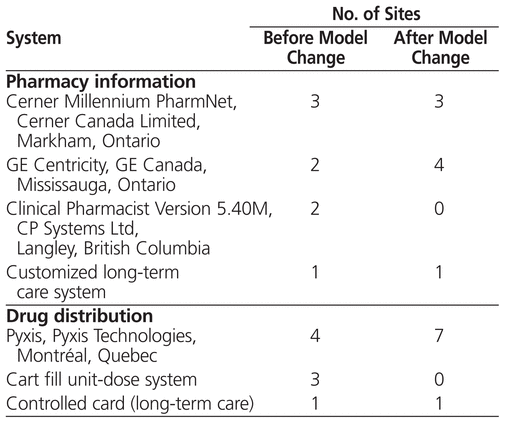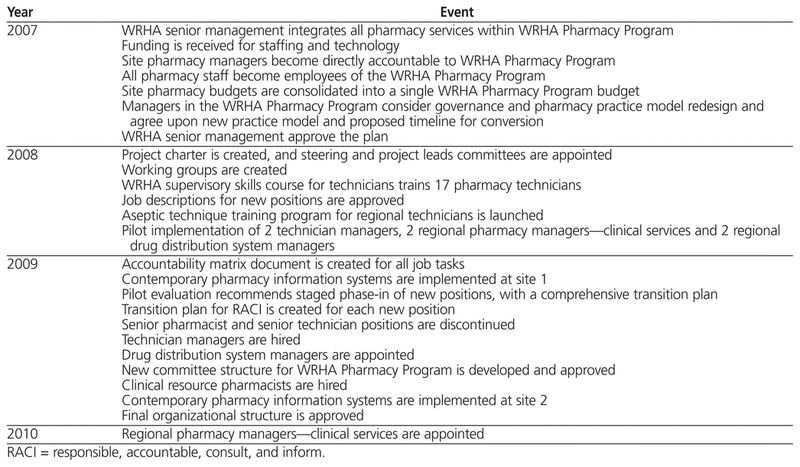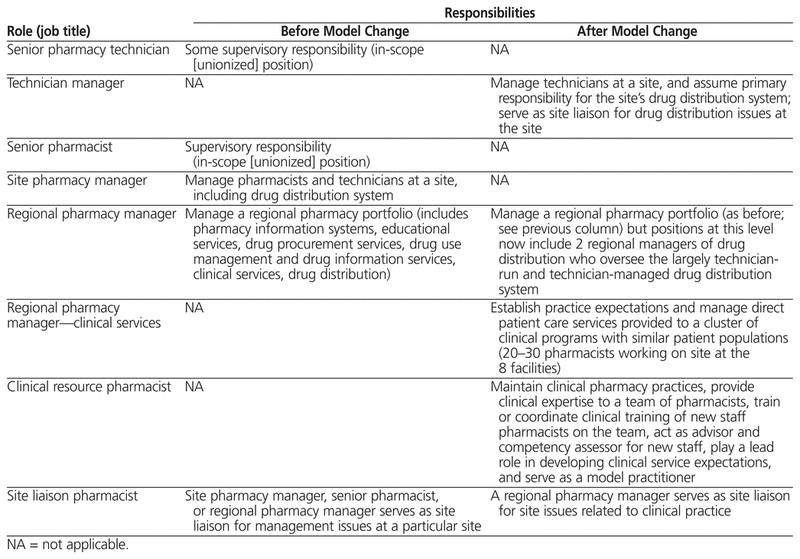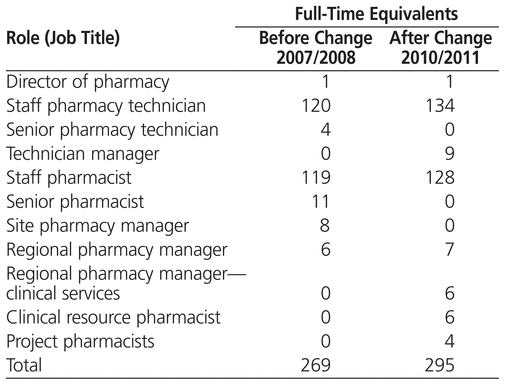
Kevin W Hall , Colette B Raymond , Donna M M Woloschuk , Nicholas Honcharik
Models of pharmacy practice are currently the focus of considerable attention within the North American pharmacy profession.1–5 In Canada, through the “Blueprint for Pharmacy” initiative, a vision and implementation plan for pharmacy practice in Canada have been established and endorsed by all pharmacy organizations.6,7 Three key objectives of the Blueprint are to incorporate technology, to enhance training and utilization of pharmacists and technicians, and to enhance accountability to patients. If pharmacists are to assume greater responsibility and accountability for management of medication therapy, they will need to spend more time performing direct patient care and less time performing technical drug distribution activities.7
These plans for the profession of pharmacy, when viewed in aggregate, call for transformative change (whereby the culture of pharmacy is changed), rather than transitional change (whereby only a process is changed). However, there is debate in the literature regarding the best approach for initiating and sustaining transformational change initiatives within organizations.8–11 This article describes the process followed and lessons learned during a Blueprint-associated transformative change initiative: organizational restructuring and implementation of a new pharmacy practice model within a large health authority.
In 1998, 9 health care facilities in Winnipeg, Manitoba, were brought under the umbrella of a single funding and administrative authority, the Winnipeg Regional Health Authority (WRHA). The WRHA delivers and manages acute, long-term, and community health services in Winnipeg (population catchments of 800 000). Simultaneously, the WRHA Pharmacy Program was created to manage and deliver pharmacy services at 8 of the health care facilities. When the WRHA Pharmacy Program was created, its pharmacy staff consisted of 269 full-time equivalent (FTE) unionized pharmacists and technicians, who provided services to approximately 2000 beds. Pharmacy managers and staff at each site had matrix accountability to the WRHA Pharmacy Program and to the health care facility where they worked.
The pharmacies within the WRHA Pharmacy Program had different pharmacy information systems and drug distribution systems (Table 1), as well as different models of clinical practice. All acute care facilities had centralized IV admixture services, which prepared an estimated 30% to 80% of all parenteral doses used in the facilities that they serviced. At all sites, pharmacy technicians performed and verified many but not all of the drug distribution activities. Most pharmacists practised in an integrated clinical–distributive practice role, where the same pharmacist was responsible for both clinical and distributive duties for the same patients each day. However, at some sites, a centralized dispensary pharmacist performed functions separate from those of the decentralized clinical pharmacists. According to an unpublished cross-sectional survey conducted in July 2008 and involving 68 WRHA pharmacists reflecting upon the most recent 3 shifts that they had worked, staff pharmacists spent 40% of paid time, on average (range 0%–80%), and clinical (advanced practice) pharmacists spent 60% of paid time, on average (range 30%–100%), performing direct patient care activities.
Table 1
Pharmacy Information and Drug Distribution Systems in Use before and after Pharmacy Practice Model Change in the Winnipeg Regional Health Authority

Before 2007, the pharmacy organizational structure was site-based, with one or more pharmacy managers (pharmacists) at each site being responsible for supervision of all pharmacy staff at that site. Most sites also had one or more senior pharmacists (unionized) and some had senior technicians (unionized) who functioned in supervisory roles. This organizational structure and pharmacy practice model were less than optimal. Although site-based pharmacy managers were technically accountable to both their respective sites and the WRHA Pharmacy Program, their emphasis was largely site-focused. Because of the lack of a regional vision, pharmacy services for similar patient groups were inconsistent across the WRHA Pharmacy Program. Pharmacists spent time performing technical drug distribution activities, which was in discord with the Blueprint for Pharmacy’s call for both pharmacists and technicians to work to their full scope of practice.6,7 Decision-making and communication did not support efforts toward standardization and operational efficiency within the WRHA Pharmacy Program, because each site’s senior management team retained site-based decision-making authority and control of site-based resources.
In 2007, senior management of the WRHA further consolidated pharmacy operations by placing all regional pharmacy staff under the direct authority of the WRHA Pharmacy Program. In addition, an initiative directed toward changing the WRHA pharmacy practice model was approved and funded ($1 million for human resources and $3.6 million per year for operational expenses for drug distribution technology). The objectives of this change initiative are presented in Box 1.
To further transition the role of pharmacists from drug distribution activities to direct patient care activities:
Separate pharmacists, to the greatest extent possible, from having responsibility for the technical activities associated with the drug distribution system.
Increase the proportion of pharmacist time that is allocated to the provision of medication therapy management services.
To further transition the role of pharmacy technicians, with the ultimate goal of having pharmacy technicians perform and check the vast majority of technical drug distribution activities.
To create management positions for pharmacy technicians who will assume day-to-day responsibility for the drug distribution system.
To develop regional teams of specialized pharmacists aligned with the organization’s clinical program model (e.g., medicine, child health)
To expand, standardize, and optimize the use of information and automation technologies within the regional pharmacy program:
Expand the implementation of standardized automated dispensing cabinet technology.
Replace legacy pharmacy information systems to lay the groundwork for a single pharmacy information system, operating on a shared server with a common database, for all acute care sites.
To ensure no reduction in the number of unionized positions within the pharmacy program.
The timeline of events in the WRHA initiative to change the pharmacy practice model are presented in Table 2. The first step was to redesign the governance model. The goal was to create a management model that could deliver a regionally standardized and operationally efficient program, within which pharmacists and technicians would work to their full scope of practice. The WRHA Pharmacy Program’s Leadership Council, consisting of the director and 14 pharmacy managers, reviewed the published literature and consulted with other Canadian health regions that had recently undergone significant organizational restructuring (specifically those in Saskatoon, Edmonton, and Halifax). The WRHA Pharmacy Program managers considered several alternative models and reached consensus on a preferred option. In June 2007, WRHA senior management approved the new governance and practice model for pharmacy.
Table 2
Timeline for Pharmacy Practice Model Change in the Winnipeg Regional Health Authority (WRHA)

The new model entailed changes in the pharmacy information and drug distribution systems (Table 1), roles and responsibilities of staff positions (Table 3), and numbers of staff in these positions (Table 4), as well as overall organizational structure (Figure 1). In the new model, staff pharmacists are organized across the WRHA Pharmacy Program in groups with similar practices, reporting to 1 of 6 regional managers of clinical services. Each of the 6 teams of pharmacists also includes a clinical resource pharmacist (reporting to the regional manager of clinical services), whose focus is on mentoring and training the other pharmacists on the team. Five other pharmacist managers are responsible for leading and managing region-wide services (e.g., education, drug procurement). New positions were created for 9 pharmacy technician managers, who supervise pharmacy technicians at the 8 sites. Finally, positions were created for 2 regional managers with responsibility for drug distribution systems (pharmacists), to whom all pharmacy technician managers and, through them, all technicians report. Within this organizational structure, 9 senior pharmacist and 4 senior technician positions were converted to staff pharmacist and staff pharmacy technician roles, respectively, resulting in no job losses. Supervisory responsibilities previously held by individuals in those positions were transitioned to regional managers of clinical services or pharmacy technician managers in the new model.
Table 3
Roles and Responsibilities before and after Pharmacy Practice Model Change in the Winnipeg Regional Health Authority

Table 4
Full-Time Equivalent Positions before and after Pharmacy Practice Model Change in the Winnipeg Regional Health Authority

|
|
||
|
Figure 1 Organizational structure before and after pharmacy practice model change in the Winnipeg Regional Health Authority. The number of managers in each type of management position is reported in Table 4. CEO = chief executive officer. |
||
The first step in implementing the pharmacy practice model change was to secure access to organizational expertise outside of pharmacy that was needed to successfully execute the change project. Given the magnitude of the anticipated changes, the WRHA Pharmacy Program secured the services of a 0.5 FTE project manager (a nonpharmacist), along with the support and expertise of the WRHA’s project management office. In addition, the provincial agency responsible for health information technology agreed to support the implementation and ongoing operation of the new pharmacy information and drug distribution systems that were being acquired.
Next, project committees and a governance structure were created. To oversee the project, the WRHA Pharmacy Program struck a Steering Committee, which consisted of a representative of WRHA senior management, the WHRA director of pharmacy (K.H.), and the project manager. A joint Union–Management Committee was formed to facilitate changes in the roles, responsibilities, and reporting relationships of unionized staff members.
Finally, the Steering Committee created multiple working groups to guide and support change initiatives in the areas of human resources, technology, clinical services, drug distribution, and education. Members of the working groups were pharmacy managers, staff pharmacists, and technicians. The Project Leads Committee consisted of the chairpersons of all working groups. The Project Leads Committee provided leadership to the working groups, identified project interdependencies, coordinated and facilitated the efforts of the working groups, identified issues and risks, and developed evaluation and communication plans. The human resources working group reviewed existing job descriptions and analyzed gaps in job tasks. Job tasks and responsibilities for each position were developed and reviewed to ensure compliance with professional and legal requirements. This working group then created new position descriptions, resolved issues related to human resources (e.g., contract concerns, changes in job responsibilities), and ensured ongoing communication with the unions. The technology working group coordinated, organized, and executed the implementation of pharmacy information system technologies (e.g., Cerner Millennium PharmNet, Cerner Canada Limited, Markham, Ontario; GE Centricity, GE Canada, Mississauga, Ontario) and automated drug distribution technologies. The technology working group also coordinated staff training for all new technologies. The clinical services working group defined the role of regional manager of clinical services and created teams of pharmacists, aligned with regional clinical programs, to support the new practice model. The drug distribution working group facilitated the implementation of drug distribution technologies across the WRHA (as listed in Table 1). The education and training working group developed and implemented required training processes, including a supervisory skills course for hospital pharmacy workplaces12 and a professional development program for technicians.13 Prior learning assessments formed the basis for the training of new pharmacy managers.14
Communication was an important 2-way process throughout the transition period. The WRHA director of pharmacy visited each pharmacy every 3 months to update staff members about the model change. Staff were encouraged to ask questions openly or privately and to provide feedback through the annual staff satisfaction survey of the WRHA Pharmacy Program. Almost all of the concerns raised by staff were related to how the planned changes would affect continued employment, the specific positions that individual staff members would hold, reporting relationships, and the roles that different categories of staff would be fulfilling in the new practice model. In addition, 10 newsletters were issued during the change period, to reinforce the underlying objectives of the practice model change and to describe progress in achieving those objectives.
A RACI tool (“responsible, accountable, consult, and inform”) was used to describe the role of each position within the new model.15 For each job task, at the appropriate time, the person responsible for the task in the old pharmacy practice model signed over the task to the person responsible in the new pharmacy practice model. This document provided both a timeline and a training outline for new managers.
Numerous factors served as barriers and facilitators to the transformative change that occurred as part of the pharmacy practice model change in the WRHA Pharmacy Program. The Steering Committee for the practice change initiative identified the following lessons learned, which may be helpful to other organizations undergoing similar transformative processes.
As a nonpharmacist, the project manager for the WRHA change initiative did not bring any fixed beliefs or expectations about the roles of pharmacists and technicians, but did bring the principles of project management, including a project charter, project plans, milestones, timelines, and a responsibility matrix. The project manager coordinated meetings, developed project plans, developed risk management strategies, and facilitated communication efforts throughout the change process. The project manager kept the working groups focused and kept the entire project moving forward.
Repetition of consistent messages is an important factor in the success of any organizational change.8–11 However, in the project described here, one of the unions objected to direct discussions between management and unionized staff, which was viewed as an infringement on the union’s exclusive right to negotiate on behalf of its members. As a result, communication to staff about the practice model change was interrupted for a period of time. This potential barrier should be recognized in unionized environments when major change initiatives are being considered.
Numerous aspects of the change progressed more slowly than anticipated. Time was required to develop and fill new positions and to manage the overlap between former and incoming managers. At times, there was confusion between managers, or between managers and staff, about their respective tasks and roles, with the potential for conflict and consequent job dissatisfaction.16,17 As in other studies,18,19 some pharmacists were reluctant to relinquish control of the drug distribution system to technicians. However, as pharmacists’ confidence about technicians’ ability to make decisions has grown, and greater job clarity has developed, these barriers have diminished.
One unforeseen challenge to the practice model change was the H1N1 influenza pandemic (in late 2009), which pre-empted frequent communication with senior management by the WRHA Pharmacy Program. The regulatory context within Manitoba during this time was also an important factor. Legislation enabling advanced pharmacist practice had been enacted in 2006, but it was not until 2010 that pharmacists approved the regulations supporting the new legislative act. No progress has been made toward creating a regulated pharmacy technician profession in Manitoba to date. Both of these external influences, and concern for the unknown, may have influenced pharmacists’ and technicians’ response to the transformational change.
Implementing organizational change is a challenge.8 We have described a transformative organizational change within a large urban health region that repositioned the pharmacy program from a site-based to a regionally focused service. As part of that change, a new management model was implemented, which focuses pharmacists and pharmacy managers on the delivery of consistent, high-quality, direct patient care services. The drug distribution system is now largely managed by pharmacy technician managers and takes full advantage of compatible regional pharmacy information systems and automated dispensing cabinet technology.
1 Pharmacy practice model initiative: objectives. Bethesda (MD): American Society of Health-System Pharmacists; [cited 2011 Apr 29]. Available from: www.ashp.org/PPMI/AboutPPMI/Objectives.aspx
2
Knoer SJ, Pastor JD, Phelps PK. Lessons learned from a pharmacy practice model change at an academic medical centre.
Am J Health Syst Pharm
2010;67(21):1862–1869.

3
Bush PW, Ashby DM, Guharoy R, Knoer S, Rough S, Stevenson JG, et al. Pharmacy practice model for academic medical centers.
Am J Health Syst Pharm
2010;67(21):1856–1861.

4
Abramowitz PA. The evolution and metamorphosis of the pharmacy practice model.
Am J Health Syst Pharm
2009;66(16):1437–1446.

5
Management Committee for Moving Forward: Pharmacy Human Resources for the Future.
Integrated key findings from the Moving Forward: Pharmacy Human Resources for the Future research program: synthesis report.
Ottawa (ON): Canadian Pharmacists Association; 2008.

6 Task Force on a Blueprint for Pharmacy. Blueprint for pharmacy: the vision for pharmacy . Ottawa (ON): Canadian Pharmacists Association; 2008 Jun [cited 2011 Feb 9]. Available from: www.pharmacists.ca/content/about_cpha/whats_happening/cpha_in_action/pdf/BlueprintVision.pdf
7 Task Force on a Blueprint for Pharmacy. Blueprint for pharmacy: implementation plan. Ottawa (ON): Canadian Pharmacists Association; 2009 Sep [cited 2011 Mar 29]. Available from: www.pharmacists.ca/content/about_cpha/whats_happening/cpha_in_action/pdf/BlueprintImplementationPlan.pdf
8 Senge P, Roberts C, Ross R, Smith R, Roth G, Kleiner A. The dance of change: the challenges to sustaining momentum in learning organizations. New York (NY): Doubleday; 1999.
9 Bridges W. Managing transitions: making the most of change. 2nd ed. Cambridge (MA): Da Capo Press; 2003
10 Hiatt JM. AKDAR. A model for change in business, government and our community . Loveland (CO): Prosci Learning Centre Publications; 2006.
11
Golden B. Transforming healthcare organizations.
Healthc Q
2006;10 Spec No.:10–19.
12 Woloschuk DMM, Raymond CB. Development of a supervisory skills course for hospital pharmacy workplaces. Can J Hosp Pharm 2010; 63(4):295–303.
13 Hayes C, Woloschuk D, Raymond C. A regional continuing professional development program for hospital pharmacy technicians [abstract]. Can J Hosp Pharm 2009;62:342.
14
Raymond CB, Woloschuk DMM. Development and utility of prior learning assessment for practicing pharmacists and technicians.
Can Pharm J
2011;144(4):192–197.
15 A guide to the project management body of knowledge ( PMBOK guide ). New-town Square (PA): Project Management Institute; 2008.
16
Gaither CA, Kahaleh AA, Doucette WR, Mott DA, Pederson CA, Schommer JC. A modified model of pharmacists’ job stress: the role of organizational, extra-role, and individual factors on work-related outcomes.
Res Soc Admin Pharm
2008;4(3):231–243.
17
Deselle SP. Job turnover intentions among certified pharmacy technicians.
J Am Pharm Assoc
2005;45(6):676–683.
18
Novek J. Clinical or industrial pharmacy? Case studies of hospital pharmacy automation in Canada and France.
Int J Health Serv
1998;28(3):445–465.

19
Novek J. Hospital pharmacy automation: collective mobility or collective control?
Soc Sci Med
2000;51(4):491–503.

The efforts of all members of the Winnipeg Regional Health Authority (WRHA) Pharmacy Program 2010 Steering Committee, the WRHA Project Management Office, the Project Leads Committee, and all working group members are gratefully acknowledged. The continuing efforts and patience of all pharmacy staff who are experiencing this transformative pharmacy practice model change are appreciated.
Canadian Journal of Hospital Pharmacy , VOLUME 64 , NUMBER 6 , November-December 2011